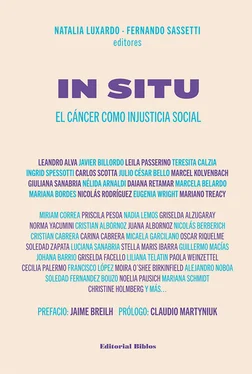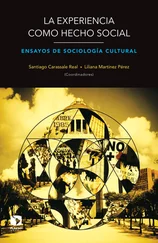PEARCE, N. (1997), “Why study socioeconomic factors and cancer?”, en M. Kogevinas, N. Pearce, M. Susser y P. Bofetta (eds.), Social Inequalities and Cancer , Lyon, International Agency for Research on Cancer (IARC Scientific Publications, 138), 17-23. http://publications.iarc.fr/293.
PLUMMER, M., C. DE MARTEL, J. VIGNAT, J. FERLAY, F. BRAY y S. FRANCESCHI (2016), “Global burden of cancers attributable to infections in 2012: A synthetic analysis”, The Lancet Global Health , 4 (9): e609-16. https://doi.org/10.1016/S2214-109X(16)30143-7.
POLLACK, C.E., S. CHIDEYA, C. CUBBIN, B. WILLIAMS, M. DEKKER y P. BRAVEMAN (2007), “Should health studies measure wealth? A systematic review”, American Journal of Preventive Medicine , 33 (3): 250-264. https://doi.org/10.1016/j.amepre.2007.04.033.
PONCE, M. (2009), “Trayectorias de cuidados del cáncer génito-mamario en mujeres adultas”, en E. López y L. Findling (eds.), Salud, familias y vínculos: el mundo de los adultos mayores , Buenos Aires, Eudeba, 109-133.
POWER, C., E. HYPPÖNEN y G.D. SMITH (2005), “Socioeconomic position in childhood and early adult life and risk of mortality: A prospective study of the mothers of the 1958 British birth cohort”, American Journal of Public Health , 95 (8): 1396-1402. https://doi.org/10.2105/AJPH.2004.047340.
PRAGER, G.W., S. BRAGA, B. BYSTRICKY, C. QVORTRUP, C. CRISCITIELLO, E. ESIN et al . (2018), “Global cancer control: Responding to the growing burden, rising costs and inequalities in access”, ESMO Open , 3 (2): e000285. https://doi.org/10.1136/esmoopen-2017-000285.
QUAN, M., N. HODGSON, R. PRZYBYSZ, N. GUNRAJ, S. SCHULTZ, N. BAXTER y M. SIMUNOVIC (2008), “Surgery for breast cancer”, en D. Urbach, M. Simunovic y S. Schultz (eds.), Cancer Surgery in Ontario: ICES Atlas , Toronto, Institute for Clinical Evaluative Sciences, 8-28.
RAMOS, S., M. TAMBURRINO, A. AGUILERA, A. CAPRIATTI, P. LEHNER y L. PEÑA (2013), Imágenes sociales del cáncer. Estudio nacional para orientar la comunicación social , Buenos Aires, Instituto Nacional del Cáncer.
SANJOSÉ, S. de, F.-X. BOSCH, N. MUÑOZ y K. SHAH (1997), “Social differences in sexual behaviour and cervical cancer”, en M. Kogevinas, N. Pearce, M. Susser y P. Boffetta (eds.), Social Inequalities and Cancer , Lyon, International Agency for Research on Cancer (IARC Scientific Publications, 138), 309-317. http://publications.iarc.fr/293.
SARFATI, D., G. GARVEY, B. ROBSON, S. MOORE, R. CUNNINGHAM, D. WITHROW et al. (2018), “Measuring cancer in indigenous populations”, Annual of Epidemiology , 28 (5): 335-342. https://doi.org/10.1016/j.annepidem.2018.02.005.
SIDORCHUK, A., E.E. AGARDH, O. AREMU, J. HALLQVIST, P. ALLEBECK y T. MORADI (2009). “Socioeconomic differences in lung cancer incidence: A systematic review and meta-analysis”, Cancer Causes Control , 20 (4): 459-471. https://doi.org/10.1007/s10552-009-9300-8.
SINDING, C. (2010), “Using institutional ethnography to understand the production of health care disparities”, Qualitative Health Research , 20 (12): 1656-1663.
SINGH, G. y A. JEMAL (2017), “Socioeconomic and racial/ethnic disparities in cancer mortality, incidence, and survival in the United States, 1950-2014: Over six decades of changing patterns and widening inequalities”, Journal of Environmental and Public Health . https://doi.org/10.1155/2017/2819372.
SIVARAM, S., M. A. SANCHEZ, B. K. RIMER et al. (2014), “Implementation Science in cancer prevention and control: A framework for research and programs in low and middle-income countries”, Cancer Epidemiology, Biomarkers & Prevention. DOI: 10.1158/1055-9965.EPI-14-0472.
STELLMAN, S.D y K. RESNICOW (1997), “Tobacco smoking, cancer and social class”, en M. Kogevinas, N. Pearce, M. Susser y P. Boffetta (eds.), Social Inequalities and Cancer , Lyon, International Agency for Research on Cancer (IARC Scientific Publications, 138), 229-250. http://publications.iarc.fr/293.
STRASSER-WEIPPL, K., Y. CHAVARRI-GUERRA y C. VILLAREAL GARZA, B. BYCHKOVSKY, M. DEBIASI, P. LIEDKE, E. SOTO-PÉREZ DE CELIS, D. DIZON, E. CAZAP, G. DE LIMA LOPES, D. TOUYA, J. SOARES NUNES, J. ST. LOUIS, C. VAIL, A. BUKOWSKI, P. RAMOS-ELIAS, K. UNGER-SALDAÑA, D. FROES BRANDAO, M. FERREYRA, S. LUCIANI, A. NOGUEIRA-RODRIGUES, A. F. DE CARVALHO CALABRICH. M. DEL CARMEN, J. RAUH-HAIN, K. SCHMELER, R. SALA y P. GOSS (2015), “Progress and remaining challenges for cancer control in Latin America and the Caribbean”, The Lancet Oncology , 16 (14).
STUVER, S.O., C. BOSCHI-PINTO y D. TRICHOPOULOS (1997), “Infection with hepatitis B and C viruses, social class and cancer”, en M. Kogevinas, N. Pearce, M. Susser y P. Boffetta (eds.), Social Inequalities and Cancer , Lyon, International Agency for Research on Cancer (IARC Scientific Publications, 138), 319-324. http://publications.iarc.fr/293.
TOMATIS, L. (1997), “Poverty and cancer”, en M. Kogevinas, N. Pearce, M. Susser y P. Boffetta (eds.), Social Inequalities and Cancer , Lyon, International Agency for Research on Cancer (IARC Scientific Publications, 138), 25-39. http://publications.iarc.fr/293.
TOWGHI, F. (2013), “The biopolitics of reproductive technologies beyond the clinic: Localizing HPV vaccines in India”, Medical Anthropology , 29: 336-343.
TUMAS, N., S.A. POU y M. del P. DÍAZ (2017), “Inequidades en salud: análisis sociodemográfico y espacial del cáncer de mama en mujeres de Córdoba, Argentina”, Gaceta Sanitaria , 31 (5). https://doi.org/10.1016/j.gaceta.2016.12.011.
UTHMAN O., E. JADIDI y T. MORADI (2013), “Socioeconomic position and incidence of gastric cancer: A systematic review and meta-analysis”, Journal of Epidemiology & Community Health , 67 (10): 854-860. https://doi.org/10.1136/jech-2012-201108.
VANTHOMME, K., L. VAN DEN BORRE, H. VANDENHEEDE, P. HAGEDOORN y S. GADEYNE (2017), “Site-specific cancer mortality inequalities by employment and occupational groups: A cohort study among Belgian adults, 2001-2011”, BMJ Open , 7 (11): e015216. https://doi.org/10.1136/bmjopen-2016-015216.
WILD, C. (2019), “Social inequalities and cancer: The imperative to act”, en S. Vaccarella, J. Lortet‐Tieulent, R. Saracci, D.I. Conway, K. Straif y C.P. Wild (eds.), Reducing Social Inequalities in Cancer: Evidence and Priorities for research . https://doi.org/10.3322/caac.21463.
1. En el análisis empírico esbozamos algunos caminos que de acuerdo a la literatura epidemiológica acá presentada conducen a estas desigualdades en el continuum del control del cáncer. Por supuesto que sabemos que estos primeros esbozos necesitarán de nuevas investigaciones para examinarlos también en los distintos niveles que no fueron incluidos. Resaltamos, no obstante, la necesidad de identificar antes de medir qué se necesita incluir y de qué distintas maneras estos aspectos pueden ser abordados.
2. Llamamos la atención sobre nuestro país, Argentina, y la labor pionera de Ángel Roffo en el Instituto de Medicina Experimental (actual Instituto Roffo), quien retomando las investigaciones experimentales de científicos japoneses de 1915, ya en las décadas de 1930 y 1940 abogaba explícitamente por políticas para la prevención del tabaquismo en las escuelas secundarias y entre las mujeres, que empezaban a ser las que fumaban, tal como está registrado en varios libros y en las publicaciones internacionales que realizó.
3. Según la Cancer Research UK ( https://www.cancerresearchuk.org/about-cancer), las rutas para reducir el riesgo de cáncer son, en orden de importancia: no fumar, mantener un peso saludable, comer frutas y verduras, consumir menos alcohol, cuidarse del sol, comer menos carne tanto fresca como procesada, comer una dieta de alto contenido de fibra y ser físicamente activo.
Читать дальше












